Open spaces have become a popular trend in modern homes.
And there are many reasons why.
First of all, this solution gives you more space and light even in the smallest living contexts. Moreover, given the increasingly smaller sizes of contemporary buildings, open spaces are an intelligent idea to make rooms appear larger.
Even where space isn't an issue, an open space has a strong aesthetic impact.
Not only. The open floor plan also allows you to save energy in terms of lighting and heating.
However, to enhance a context of this kind, finding the right lighting is essential more than ever to avoid, for example, illuminating some areas too much at the expense of others.
Therefore, the lighting design project must be extremely precise and detailed, both in terms of the location and the choice of lighting fixtures.
The goal is to provide uniform lighting. However, you have to bear in mind that different areas in the same space will have different light requirements based on the activities carried out in them.
Being an open environment, in addition to the arrangement of the furnishings and accessories, the lighting will allow you to create distinct areas and make them functional and welcoming at the same time.
So how do you illuminate an open space? We will provide an in-depth answer to that question in this article.
In particular, we will take a look at:
- The difference between a loft and an open space
- Open space: advantages and disadvantages
- How to illuminate an open space: 4 best practices
- 4 original solutions to illuminate an open space
- How to illuminate an open space in an original way
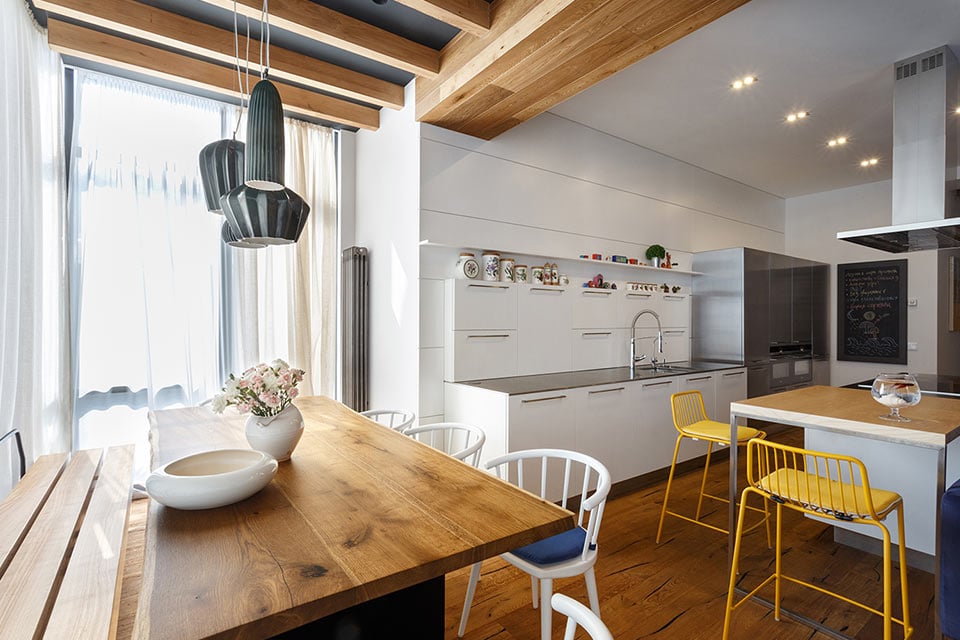
Sahara
The difference between a loft and an open space
To illuminate an open space without making mistakes, it is first of all important to define what is meant by "open space".
In particular, it must be distinguished from a loft, because, being both unique, they are often mistakenly used as synonyms.
An open space is an apartment or house characterized by the unity of some rooms instead of divided by walls like we see in the traditional architectural style.
A loft, on the other hand, is usually a large, abandoned industrial or commercial space that gives rise to a private home, characterized by the almost total absence of dividing walls, higher ceilings than normal residential buildings (about 4 or 5 meters), and taller and wider windows.
In a loft, the bricks, plaster, skirting boards, and so on are neither finished nor decorated. This type of solution, which looks like a large studio apartment, usually prefers industrial-style furniture and lighting.
So, they are two different living contexts that require a different approach to design to create the right atmosphere with lighting.
Open space: advantages and disadvantages
Before going into detail on how to illuminate an open space, there are a few advantages and disadvantages of this housing solution that the designer should consider and share with the client.
As we have seen, an open space is an area of the house that combines different environments.
The combination that represents the most typical open space configuration is the union of the living room with the dining room and open kitchen. This creates a large living area that restores a more convivial atmosphere to the home.
The advantage is that whoever is in the kitchen can speak directly with whoever is, for example, lying on the sofa or setting the table, without having to raise their voice to make themselves understood. They can see who they are speaking to because there aren't any walls separating them.
This solution also allows you to save energy, since it is possible (although not recommended) to also use a single light source for general lighting.
On the other hand, before proposing this solution to a client, the disadvantages of an open space must also be considered, i.e. the fact that having a kitchen that opens into the living room can favor the spread of bad smells throughout the living area as well as noises from appliances.
These elements can disturb those who are watching TV or reading on the sofa.
To avoid these drawbacks, you could install a retractable or casket door which, when needed, can separate the kitchen from the rest of the living space.
Also, using a retractable door strategically will not affect the quality of the lighting.
Having made these considerations of a general nature, let's take a look at some practical tips to successfully illuminate an open space, finding the right balance between decorative lighting and technical lighting.
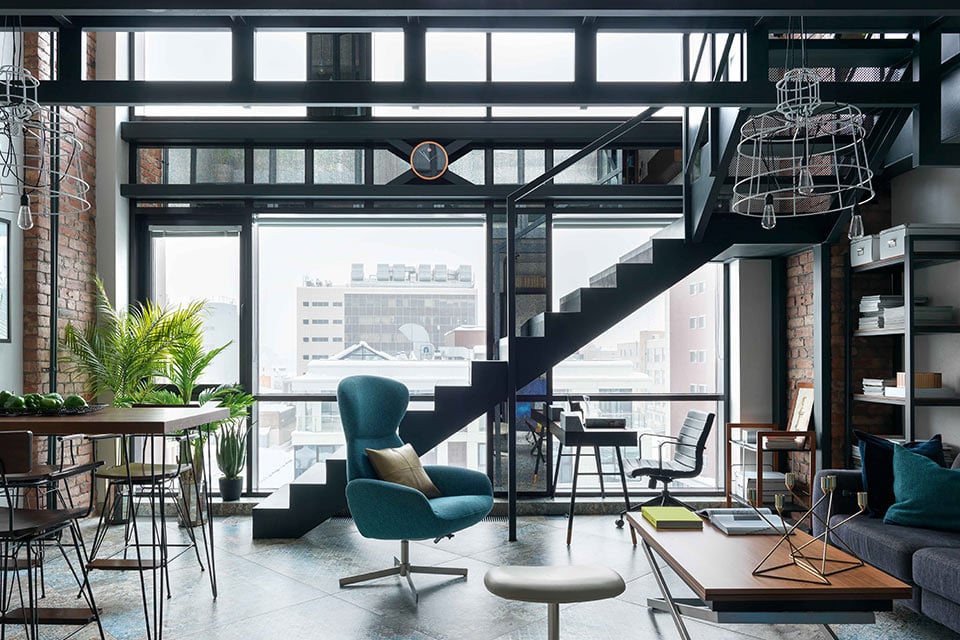
Sisma
How to illuminate an open space: 4 best practices
When developing a lighting design project for an open space, the goal must be to make this space welcoming, inviting, and extremely functional.
Therefore, to illuminate an open space, it is essential to study interior designer lighting that allows you, in addition to giving a strong aesthetic impact, to also perform the various activities to the fullest throughout the room.
Let's see how.
1. Install several light points
Due to the usually rather large surface, when it comes to deciding how to illuminate an open space, it is always better to avoid a single light point, first because a single light would not be sufficient and, secondly, you should have different types of light depending on the function of the space.
As interior lighting designers are well aware, it is possible to distinguish between three levels of lighting:
- Ambient lighting, or the general lighting of the environment, representing the overall amount of light available in a room;
- Task lighting, or lighting aimed at carrying out specific tasks;
- Accent lighting, whose function is to emphasize certain architectural features, furnishing elements, or valuable accessories as well as add atmosphere.
Even if it is an open space, and indeed even more precisely for this reason, it is necessary to ideally divide the environment into specific areas, each of which will have its own lighting needs.
Therefore, it is essential to identify which areas require a stronger and more direct practical light (for example, the kitchen hob or dining table) and those that instead need a softer light and atmosphere (for example, the living room).
Using a layered lighting scheme will allow you to create the right mood without giving up the right visual comfort.
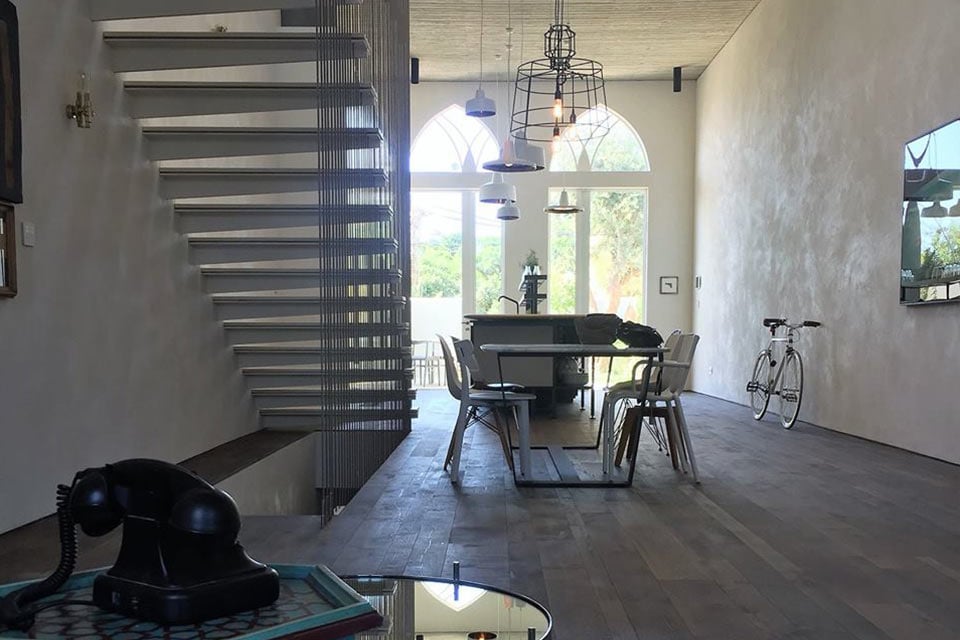
Sisma and Gangster
2. Install different types of lights
As we have already mentioned, in the kitchen and the living room (the most frequent open space situation), it is necessary to install different types of lights.
For example, a direct and powerful light where you cook will certainly be more useful so you can carry out tasks without straining your eyes.
In the living room, on the other hand, to watch TV or read, a more diffused and less intense light will be sufficient.
So, we are giving you the green light to use different lamps as long as they are in harmony with each other.
Let's look at some examples.
Suspension lamps or spotlights for the kitchen
Suspension lamps or spotlights are preferred in the kitchen area.
In fact, these solutions offer more powerful and direct light and allow you to create different combinations between different types of lamps, with continuity.
Not recommended for this area are wall lamps, because in addition to illuminating less intensely, with the vapors from the cooking area, they tend to get dirty more easily.
Creativity in the living room
For the living room, there are so many possibilities: from spotlights to wall lamps, to floor or table lamps.
To illuminate the living room in an original way you really are spoiled with choices.
For this area, therefore, it is possible to leave room for the client's personal taste, on the condition that you don't overdo it.
In fact, since it is an area used for conviviality, reading, listening to music, and more generally for relaxation, you should choose a soft light that helps create the right atmosphere.
To illuminate the living room of an open space, the smart idea could be to opt for dimmable lamps, in order to adapt the light to the different moments of the day and different activities, and to satisfy all the needs of those who spend time in the environment.
3. Match the lamps with the style of the environment
Another element to consider when carrying out a lighting design project, and in particular illuminating an open space, since it is a single space, is the overall style, which must be coherent.
So, it is a good idea to choose different lamps, and it is necessary to identify a design that gives harmony to the rooms and is able to offer luminous continuity that will give an overall visual perception.
Furthermore, it is essential to match the lighting with the style of furnishings so that the overall mood is well defined and it doesn't feel messy.
Finally, not to be forgotten in the choice of light installations is that the goal is to find the right balance between decorative lighting and technical lighting.
There are many proposals for designer lamps capable of fully responding to this need.
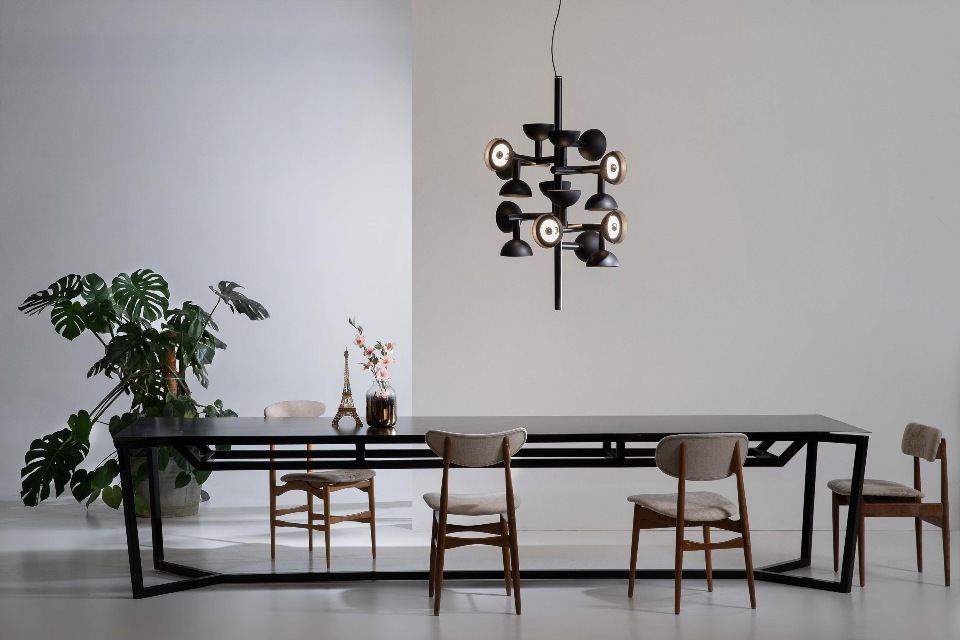
Sibilla
4. Don't forget about accent lighting
We have already talked about the importance of creating a layered lighting project to illuminate an open space.
Accent lighting deserves a separate discussion because neglecting it could be a serious mistake, and you risk compromising the final aesthetic result.
Accent lighting allows you to highlight particular architectural features (like exposed beams or a stone wall), sculptures, works of art, or other valuable accessories that deserve to be highlighted.
It is therefore fundamental in the design phase of the open space to think about which areas within the open space you want to highlight.
As for the choice of lighting fixtures, there are several possibilities.
For example, to highlight a particular wall, you could use some wall lamps such as Work in Progress. This lamp recalls those of construction sites, but, thanks to its pure white and romantic floral decorations, it embellishes even the most refined environments.
A table lamp like Bag can instead highlight a precious vase or a design sculpture.
4 original solutions to illuminate an open space
We have seen the guidelines to follow to illuminate an open space.
With this premise the keyword to be inspired by to amaze clients by offering original solutions is: creativity!
Creativity that, however, cannot and must not ignore the tastes and preferences of the client, which must, for this reason, be involved in the creation of the lighting design.
So let's look at 4 solutions of designer lamps by Karman you can use to illuminate an open space in an original way without sacrificing style and elegance, able to amaze and arouse emotions through light.
We will focus on the most frequent situation, namely that of an open space kitchen-living room.
In general, suspension lamps are an excellent idea for an open space since, in this type of context, there may be no walls or other points where you can install lamps.
Suspensions are perfect both as a source of ambient lighting and task lighting, and at the same time have a strong aesthetic impact.
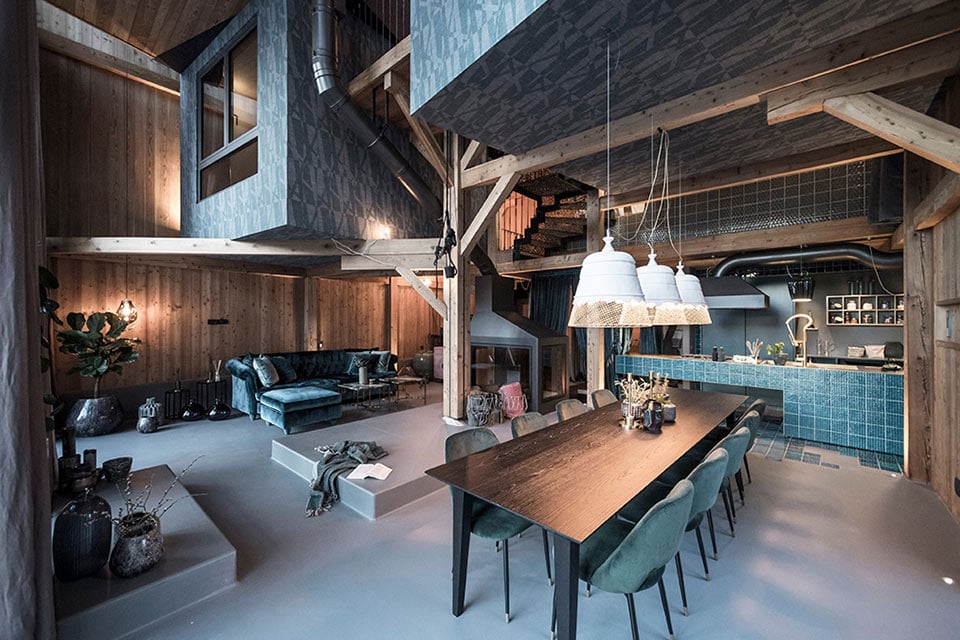
Domenica and Sahara
1. Cluster: a touch of class above the island
If the kitchen in question has a modern or industrial style and an island, it certainly deserves to be highlighted.
This objective can be achieved by installing a series of designer suspension lamps that project onto the work surface.
This solution to illuminate an open space will not only provide the necessary practical light but will embellish the kitchen area, integrating it perfectly with the living area.
An example? Cluster, functionality and great formal cleanliness at its best. This solution allows you to give way to creativity by realizing compositions that bring together several decorative Karman lamps, in different shapes, materials, transparencies, and colors to create an innovative and highly appealing suspension.
2. Snoob: a striking lamp in an open kitchen
A suspension lamp that catches the eye and prompts the eye to look upwards into an open kitchen.
Snoob comes in white or black lacquered aluminium, and its shapes evoke the chandeliers featured in ancient Baroque palaces but revisited in a modern way.
The clean lines do not affect its grandeur, and it is a proposal capable of surprising when found in the center of an open-plan kitchen.
To provide task lighting where needed, our advice is to integrate the suspension lamps with spotlights, recessed lights, and LED strips under the wall units.
3. Cell: magical lanterns above the dining table
To illuminate an open space, like above the dining table, you need adequate visibility but also the right atmosphere.
One or more suspensions, based on the size of the table in question, such as Cell, in white or bronze metal wire, will contribute to outlining the dining area discreetly and elegantly, without going unnoticed.
Cell has the structure and spirit of ancient Chinese lanterns and will give a magical touch to the dining table.
4. Black Out: create the right atmosphere in the living room
The living room is a space for relaxation but also a meeting place for family or guests.
In this important area of home, it is possible, and indeed recommended, to combine and use different light sources wisely: suspensions, wall lamps (to be installed, for example, on both sides of the sofa), but also floor lamps and table lamps so you can set the right mood at any time of the day.
An example? Black Out, with a fiberglass filament structure that is available in both the suspension and floor lamp versions.
Fiberglass filaments allow a warm and welcoming light to filter through it.
For those in search of truly unique atmospheres, the candle holder accessory in white ceramic that seems to float in the air coming down from under the lampshade is ideal.
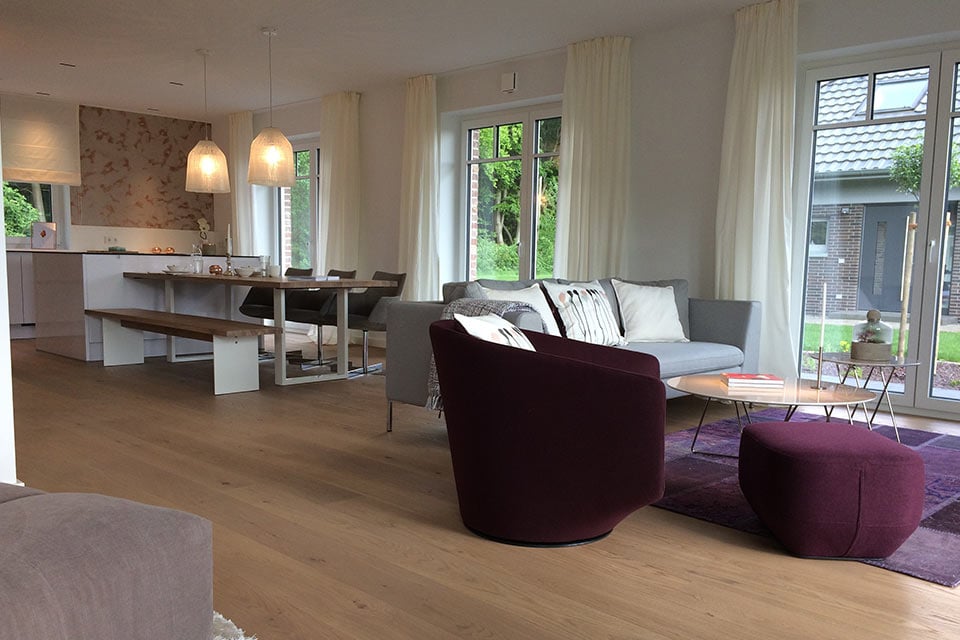
Black Out
How to illuminate an open space in an original way
We have seen how lighting plays a fundamental role in the design of an open space. It is precisely through light that it is possible to make space a whole, creating at the same time different and separate functional zones.
To illuminate an open space, the right union between art and science, and technique and creativity is necessary.
In particular, it is necessary to:
- Install several light points to create a layered lighting design;
- Install different types of lamps based on the specific area and its function;
- Choose decorative lamps consistent with the mood of the environment;
- Use accent lighting to give character and personality.




